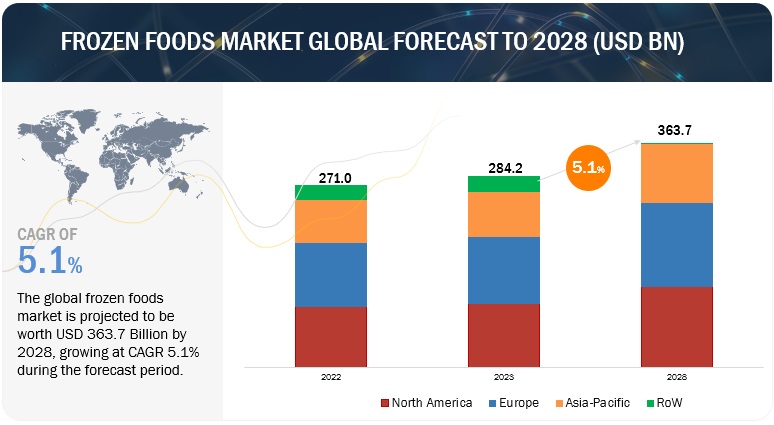Frozen Foods Market Growth by Emerging Trends, Analysis, & Forecast
At a CAGR of 5.1%, the global frozen foods market is projected to have grown from USD 284.2 billion in 2023 to USD 363.7 billion by 2028. One of the primary advantages is their longer shelf life compared to fresh alternatives. This quality significantly reduces food waste, a growing concern globally. Consumers can confidently stock up on frozen foods, knowing they won't spoil quickly, aligning with sustainability goals.

The proliferation of e-commerce has further propelled the frozen foods market. Online shopping platforms offer unparalleled convenience, allowing consumers to access and order frozen foods with ease. This digital accessibility has broadened the market's reach and made it simpler for individuals to incorporate frozen food products into their meal plans. Globalization plays a pivotal role as well, with an extensive range of international cuisines available in frozen form. Consumers can now enjoy a diverse culinary experience from the comfort of their homes, adding excitement and variety to their diets.
Download PDF Brochure: https://www.marketsandmarkets.com/pdfdownloadNew.asp?id=130
Opportunities: Rising disposable incomes in emerging economies, driving frozen foods segment
The expanding trade of processed foods presents a significant opportunity within the frozen foods market. As global trade networks continue to grow, the frozen foods industry stands to benefit in several ways. Firstly, increased international trade facilitates the exchange of a wide variety of processed foods, including frozen options. This enables consumers to access a diverse range of products from around the world, expanding their culinary horizons. Secondly, globalization supports the import and export of frozen food ingredients, allowing for cost-effective sourcing of raw materials. This can lead to more competitive pricing and increased profitability for frozen food manufacturers. Moreover, international trade encourages innovation and the development of new frozen food products to meet the tastes and preferences of different regions. This diversity in offerings can attract a broader consumer base and drive market growth.
Challenges: Lack of Cold Chain Infrastructure in Developing Countries
The lack of adequate cold chain infrastructure in developing countries poses a formidable challenge to the frozen foods market. Cold chain infrastructure, which includes temperature-controlled storage, transportation, and distribution facilities, is essential for maintaining the quality and safety of frozen food products. In many developing nations, such as South Africa and Kenya, these critical components of the supply chain are underdeveloped or insufficient. This deficiency hampers the frozen foods market in multiple ways. It can lead to temperature fluctuations during transportation and storage, resulting in quality degradation and potential food safety risks. Moreover, the limited cold chain infrastructure restricts the availability of frozen products in remote and underserved areas, limiting market penetration and growth potential.
Make an Inquiry: https://www.marketsandmarkets.com/Enquiry_Before_BuyingNew.asp?id=130
Europe Holds the Largest Share of the Frozen Foods Market
Europe is a major hub for frozen vegetable consumption, driven by busy lifestyles and a growing demand for affordable, nutritious, and convenient food options. Rising incomes and changing dietary preferences are propelling this market, with consumers shifting towards plant-based diets. Key opportunities for vegetable suppliers are found in countries like Germany, France, Belgium, Italy, and the Netherlands. Public awareness of the superior nutritional value of frozen vegetables over fresh and refrigerated ones is boosting demand, especially among younger generations.



